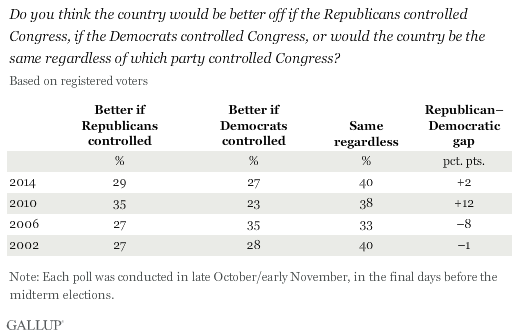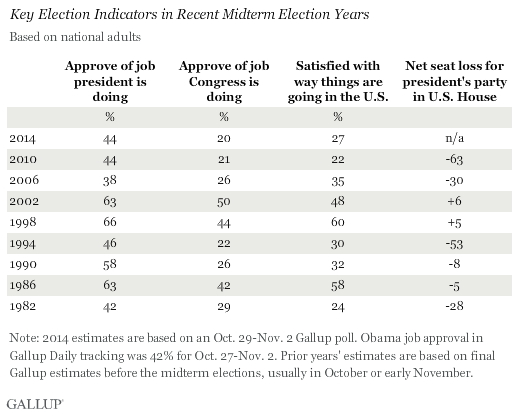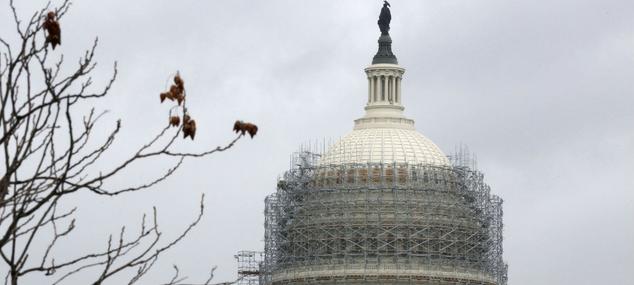Story Highlights
- Voters do not favor either party for control of Congress
- In past "wave" elections they clearly favored one party
- Key midterm indicators favor GOP, but less than earlier in '14
PRINCETON, N.J. -- U.S. registered voters do not have a clear preference on whether the country would be better off if Republicans (29%) or Democrats (27%) controlled Congress, with 40% saying it would be the same regardless of which party is in power. In the 2006 Democratic and 2010 Republican "wave" elections, voters had a clear preference for the party that won. Today's views are most similar to the 2002 elections, which saw more modest change in the party composition of Congress.

The 2006 and 2010 elections were contested at a time when one party had control of the presidency and both houses of Congress, and voters were more likely to think the country would benefit from shifting control of Congress away from the majority party than keeping it with that party. In 2002, as now, party control was divided, with the president's party having control of one house of Congress but not the other. The blurred lines of accountability could explain why voters did not more clearly show a preference for which party controlled Congress in 2002 or this year.
But other aspects of Americans' current mood look more like they did in 2006 and 2010 -- and in other years, such as 1982 and 1994, in which there were major shakeups in congressional membership -- than in 2002. These include their subpar ratings of the job performance of the president and of Congress, and their low satisfaction with the direction of the country as a whole.

The president's party typically loses seats in midterm elections, but those losses tend to be greater when Americans' approval ratings of the president, and of Congress, are relatively poor, and when Americans are not satisfied with the way things are going in the United States. In years like 1986, 1998 and 2002, when Americans were generally upbeat about the state of the nation, there tended to be less change in the membership of Congress in the midterm elections.
Importantly, though these key indicators are still low on an absolute basis, most of the current updates are a bit more positive than what Gallup measured earlier this year. For example, congressional job approval has averaged 14% so far in 2014 and has not been as high as the current 20% since just before the 2012 elections.
Also, the current 27% satisfied with the way things are going in the United States exceeds the 2014 average to date of 23%; satisfaction was last at this level in July 2013.
President Barack Obama's job approval rating, 44% in the Oct. 29-Nov. 2 poll, is nominally more positive, but not significantly different from, the 42% he has averaged in Gallup Daily tracking over the past week.
Americans' improving economic confidence may be one reason the current national mood indicators are a bit more positive than they have been. And while the level of improvement is not enough to fundamentally erase the Republicans' advantage going into Tuesday's elections, it does suggest the negative climate that has been providing the wind at the GOP's back may not be quite strong as it was a few months, or even weeks, ago.
Implications
The national political climate, as measured by several key indicators of Americans' satisfaction with current conditions in the country and how the nation is being governed, usually gives a strong sense of which way a midterm election will go. And this year, with a Democratic president in office and Americans in a generally negative mood, the fundamentals point to 2014 being a better year for the Republican Party than the Democratic Party. Indeed, the general consensus among political experts is that the Republicans will increase their majority in the House of Representatives and could win control of the Senate.
And though the key indicators are about as negative this year as they have been in past wave elections, 2014 may not see the same level of shakeup in Congress as was the case in 2006, 2010 and other years. The key variable working against a 2014 wave may be that divided party control in Washington already exists when it did not in 1994, 2006 and 2010, and thus, frustrated voters this year have no clear way to act on their frustration by changing the party composition of the federal government. With Obama in office for two more years and little chance of Republicans losing their House majority, divided government should still be in place regardless of which party has the Senate majority, and the way the nation is governed over the next two years may not materially change.
Survey Methods
Results for this Gallup poll are based on telephone interviews conducted Oct. 29-Nov. 2, 2014, with a random sample of 1,832 adults, aged 18 and older, living in all 50 U.S. states and the District of Columbia.
For results based on the total sample of national adults, the margin of sampling error is ±3 percentage points at the 95% confidence level.
For results based on the total sample of 1,590 registered voters, the margin of sampling error is ±3 percentage points at the 95% confidence level.
Each sample of national adults includes a minimum quota of 50% cellphone respondents and 50% landline respondents, with additional minimum quotas by time zone within region. Landline and cellular telephone numbers are selected using random-digit-dial methods.
Learn more about how Gallup Poll Social Series works.

